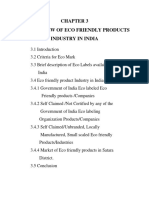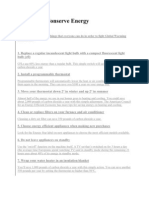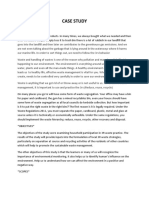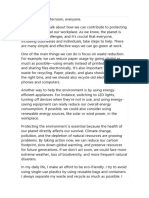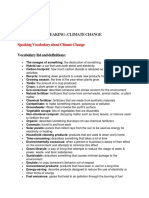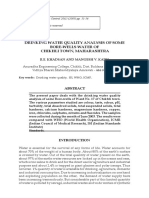Become Eco Friendly
Become Eco Friendly
Uploaded by
Nidhi SanghviCopyright:
Available Formats
Become Eco Friendly
Become Eco Friendly
Uploaded by
Nidhi SanghviOriginal Description:
Copyright
Available Formats
Share this document
Did you find this document useful?
Is this content inappropriate?
Copyright:
Available Formats
Become Eco Friendly
Become Eco Friendly
Uploaded by
Nidhi SanghviCopyright:
Available Formats
Being eco-friendly or environmentally friendly is becoming more and more importa
nt. You can see the term used in everything from job ads to dating profiles to e
ven listings houses and vacation homes. So, what is being eco-friendly?
The simplest way to define what being eco friendly means is to say that it is th
e act of living with intent. The intent is focused on not creating harm to envir
onment, and to prevent as much harm from occurring to the environment through yo
ur interactions with it. It goes beyond an idea and extends to actual practices
that influence how communities, businesses and individuals conduct themselves. B
eing eco-friendly goes far beyond just turning off lights when you leave the roo
m or separating your garbage for recycling
it is about changing the purpose of h
ow you live.
You can start to become eco-friendly by becoming aware of the how your choices e
ffect the environment. There are three basic stages to becoming eco-friendly, th
ey are
Learning to consume items that cause minimal environmental harm.
Discovering the extent of your carbon footprint and acting to lessen that footpr
int on the environment.
Striving to support others that work to live and produce eco-friendly and sustai
nable communities.
As you can see, the first step is about you immediately acting to change the way
you consume things in life. This means changing your habits about driving, what
types of packaging you use, how you dispose of waste and how you use natural re
sources.
The second step looks at the extent of your carbon imprint that you may not be a
ble to change
such as living in a house, having to drive a car or the type of em
ployment you have and acting with the responsibility to lessen that imprint to t
he best of your ability.
The last one involves actively seeking connections with other eco-friendly perso
ns, communities and businesses and choosing to network and support them to creat
e a more sustainable life. That may not be as easy as it seems, which is why it
is the third step. To live in and support a sustainable community and economy yo
u may not have many of the conveniences that you are used to by far this is the
hardest thing to adjust to.
Here are 10 Steps to Become Eco-friendly:1. 3 R s of Waste Hierarchy: The 3 R s of waste hierarchy can reduce the amount of w
aste generated and improve the waste management processes. Reducing what is prod
uced and what is consumed can reduce the amount of waste that is generated. Reus
e items for different purposes instead of disposing them off. Recycle items like
aluminum cans, plastic, paper, glass that can be shaped into a new item.
2. Conserve Water and Electricity: It takes energy to produce fresh water and el
ectricity. Few simple ways like turning off lights when not in use, fixing leaka
ges, proper insulation, using maximum daylight, installing energy efficient wind
ows, purchasing energy efficient gadgets can reduce your daily energy consumptio
n. Learn here more about 151 ways to conserve energy.
3. Plant More Trees: We all know why we need more trees on this planet. They giv
e us oxygen, fruits, timber, prevent soil erosion, control floods, provide shelt
er to wildlife. Massive scale deforestation in last couple of decades has reduce
d forest area by significant percentage. The need of hour is to work with enviro
nmental groups to educate more people and plant more trees so as to make this p
lanet clean and eco-friendly.
4. Protect Local Water Sources: Hazardous waste materials like paint, oil, ammon
ia and other strong chemical solutions should never be disposed on the ground as
they ll seep into the groundwater. Join local water conservation groups and fight
against water polluters who dump their industrial waste in rivers.
5. Drive Less, Walk More: A simple and yet more effective way to live eco-friend
ly life is to either take public transportation for your daily commuting needs o
r try pooling in with your office colleagues to save fuel and reduce your carbon
footprint. If your office is couple of miles away from home, you can either sta
rt half an hour early and walk on foot or ride a bicycle. If you re and avid trave
ler, you can follow these green travel tips.
6. Buy Energy Efficient Products: Energy efficient products with 5 start energy
rating consume less energy and prove to be eco-friendly. For instance, CFL bulbs
consume 40% less energy and last 10 times longer than traditional bulbs.
Eco-friendly house
7. Buy locally Grown Products: When you buy or produce locally grown products, y
ou are actually reducing your carbon footprint in the form of using less plastic
bags, saving fuel to get vegetables from the market, using less packaged materi
al .. . Apart from this, you can also sell surplus to your friends or relatives.
8. Prevent Littering: Litter can originate from construction and demolition site
s, households, industries, uncovered trucks, pedestrians, and moving vehicles. L
ittering can have big impact on environment, wildlife and local tourism industry
. Being a responsible citizen, it s our responsibility to make our cities clean an
d impart same education to our kids.
9. Buy Recycled Products: Always look out for recycling symbol when you visit gr
ocery shop to buy items for your home. That will make you environmentally respon
sible and eco-friendly. Also, try to carry grocery bag with you to avoid buying
items in plastic bags that will later end up in landfills.
10. Join Environmental Groups to Combat Pollution: Protecting mother Earth is ev
eryone s responsibility including you. The best you can do is to join different en
vironmental groups in your city and provide helping hand to make this planet env
ironmentally friendly.
The Eco-friendly Life
Living the eco-friendly life has some advantages and disadvantages. As mentioned
earlier, one of the disadvantages is that may have to forgo some of the more mo
dern conveniences. Not many, but the conveniences like fast foods and certain ty
pes of luxury activities do little more than create a burden on the environment.
One of the best examples is the idea of the personal car. While you may realist
ically need a personal vehicle, you do not need one that gets poor gas mileage o
r is made with luxury accessories or advanced electronics that are impractical,
and also consume vital natural resources.
That Land Rover may have a special gauge to tell you if you are right side up or
upside down in the event of a sandstorm, but chances of encountering a sandstor
m in New Jersey, much less actually doing an activity that would need a vehicle
like the Rover is so minimal that it is a luxury that is unnecessary.
The Eco-friendly Business
Creating an eco-friendly business means you are mindful of the waste products yo
ur business creates, and the way it uses resources to do business. There are ver
y many options for how you can do packaging and advertising that have a much low
er impact on the environment. As a business, you stand to make a stronger impact
in how fuel conservation is approached by working with suppliers that utilize h
ybrid technologies and making sure that a part of what you consider when buying
or selling is the cost and impact of the shipping of the product.
The Eco-friendly Community
Growing an eco-friendly community is getting easier. There are more and more com
munity gardens, swap meets and farmer s markets that make it easier for an entire
community to actively participate in eco-friendly activities. If your community
doesn t have any of these, you should consider getting them started.
You might also like
- Drymax 100 + PDC @ENDocument38 pagesDrymax 100 + PDC @ENMarcelo Rodriguez Ospina100% (1)
- Entrepreneurship Business Plan GreenholicDocument42 pagesEntrepreneurship Business Plan GreenholicTan Wzzz100% (1)
- Environment Crossword PuzzleDocument2 pagesEnvironment Crossword Puzzleamrinarizan4850% (2)
- Evs Joural Assignment STD XiiDocument5 pagesEvs Joural Assignment STD XiiTryNo ratings yet
- Environment Friendly ProductsDocument11 pagesEnvironment Friendly ProductsKrishna Chandran PallippuramNo ratings yet
- Eco ProductsDocument29 pagesEco Productssreekutty A SNo ratings yet
- Water Conservation - Sustainable Living - IndiaDocument3 pagesWater Conservation - Sustainable Living - IndiaRavi Prakash MehtaNo ratings yet
- 50 Ways To Conserve EnergyDocument7 pages50 Ways To Conserve EnergyKier Jucar de GuzmanNo ratings yet
- Proposal On Waste Management - 29th NovDocument4 pagesProposal On Waste Management - 29th NovAdilAdNo ratings yet
- PHD Research Proposal OutlineDocument2 pagesPHD Research Proposal Outlinemariam murtazaNo ratings yet
- What Is An Eco - Friendly RoutineDocument1 pageWhat Is An Eco - Friendly RoutinePaola alexandra ranilla veraNo ratings yet
- School Project Proposal ReportDocument22 pagesSchool Project Proposal ReportIshak MalikNo ratings yet
- 4Rs BY ALYSSA ALEGADODocument17 pages4Rs BY ALYSSA ALEGADOAlyssa AlegadoNo ratings yet
- Become Eco FriendlyDocument7 pagesBecome Eco FriendlysushilNo ratings yet
- Eco IntroDocument21 pagesEco IntroSOHEL BANGINo ratings yet
- Kahalagahan NG KalikasanDocument1 pageKahalagahan NG KalikasanRoden LacabaNo ratings yet
- Peace 2 Week 1 Q4Document20 pagesPeace 2 Week 1 Q4Darlene MotaNo ratings yet
- Peace 2 W1 Q4Document21 pagesPeace 2 W1 Q4Darlene MotaNo ratings yet
- BigggDocument45 pagesBigggAinul NajaaNo ratings yet
- Top 10 Ways You Can Stop Climate Change For BangladeshDocument3 pagesTop 10 Ways You Can Stop Climate Change For BangladeshKarisma AmjadNo ratings yet
- The Lazy Environmentalist on a Budget: Save Money. Save Time. Save the Planet.From EverandThe Lazy Environmentalist on a Budget: Save Money. Save Time. Save the Planet.Rating: 4.5 out of 5 stars4.5/5 (9)
- Ways To Preserve NatureDocument3 pagesWays To Preserve NatureMa.Elyza BalastaNo ratings yet
- 12 Ways To Take Action To Reduce Global WarmingDocument4 pages12 Ways To Take Action To Reduce Global WarmingPhú ThiênNo ratings yet
- Week#10 CitzenshipDocument23 pagesWeek#10 CitzenshipSaad AghaNo ratings yet
- Cwts Romnick PanelooDocument2 pagesCwts Romnick PanelooMarisse Ann Umerez PasacayNo ratings yet
- 10 Ways To Conserve The EnvironmentDocument2 pages10 Ways To Conserve The EnvironmentJosé Manuel Herrera Barba100% (1)
- NSTP Project ProposalDocument3 pagesNSTP Project ProposalReena Maye Escalante MataNo ratings yet
- Class 12 TH Projects EvsDocument7 pagesClass 12 TH Projects EvsRit AnnaNo ratings yet
- Save EarthDocument18 pagesSave Earthmuhammad erizaNo ratings yet
- Ronnel R.Rosales Bsed-Mapeh: Global WarmingDocument3 pagesRonnel R.Rosales Bsed-Mapeh: Global WarmingGel MaulionNo ratings yet
- A Plan That The Community May Use To Conserve and Protect Its Resources For Future GenerationsDocument7 pagesA Plan That The Community May Use To Conserve and Protect Its Resources For Future Generationsjoselle reyesNo ratings yet
- Importance of Recycling WasteDocument4 pagesImportance of Recycling WasteTan Looi SeaNo ratings yet
- Thesis Statement About Waste ReductionDocument5 pagesThesis Statement About Waste Reductionafcnyiatk100% (2)
- To Live A More Environment-Friendly Life Means Making Daily Choices That Reduce Our Negative Impact On The Environment.Document1 pageTo Live A More Environment-Friendly Life Means Making Daily Choices That Reduce Our Negative Impact On The Environment.Максим ВласенкоNo ratings yet
- Texto Apresentação Projeto SustainabilityDocument7 pagesTexto Apresentação Projeto Sustainabilityleonor.isabel.silva.abreuNo ratings yet
- Sustainable LivingDocument5 pagesSustainable Livingcarsofpakistan92No ratings yet
- Sustainability Handbook Sustainable Practices To Reduce Environmental Impact at HomeDocument2 pagesSustainability Handbook Sustainable Practices To Reduce Environmental Impact at HomeCristiana FelicianoNo ratings yet
- Public Speaking Text 2023Document2 pagesPublic Speaking Text 2023Syuhada LatifNo ratings yet
- English Project EvironmentDocument4 pagesEnglish Project EvironmentAldiona DaulleNo ratings yet
- English Project EvironmentDocument4 pagesEnglish Project EvironmentAldiona DaulleNo ratings yet
- 4Rs HandbookDocument7 pages4Rs HandbookgabinuangNo ratings yet
- Sustainable LivingDocument10 pagesSustainable LivingKimberly TaycoNo ratings yet
- Directed Writing Clean EnvironmentDocument2 pagesDirected Writing Clean Environmentyudrea88No ratings yet
- Introduction Case StudyDocument5 pagesIntroduction Case StudyDarren Chelsea PacienciaNo ratings yet
- Lesson 8 Forest Protection Conservation and DevelopmentDocument33 pagesLesson 8 Forest Protection Conservation and Developmentjelo bacaniNo ratings yet
- Unit Ii IDocument4 pagesUnit Ii IRizwanNo ratings yet
- TNC QUARTER-3 WEEK-7 SESSION-1 Planetray-NetworksDocument30 pagesTNC QUARTER-3 WEEK-7 SESSION-1 Planetray-NetworksJhea Ann MorfeNo ratings yet
- A Plan That The Community May Use To Conserve and Protect Its Resources For Future Generations.Document8 pagesA Plan That The Community May Use To Conserve and Protect Its Resources For Future Generations.jj62% (21)
- Environmental Issues: Going GREEN!!!Document33 pagesEnvironmental Issues: Going GREEN!!!Ma Hdi ChoudhuryNo ratings yet
- EssayDocument1 pageEssayMadhusudhana BandapalliNo ratings yet
- In Line With The ThemeDocument8 pagesIn Line With The ThemeHiren MahetaNo ratings yet
- Unit 5Document5 pagesUnit 5thanhhuyen210k5No ratings yet
- Reuse, Recycle and ReduceDocument9 pagesReuse, Recycle and Reducemary antonette manaloNo ratings yet
- Assessment Task 2 BSBMGT502Document6 pagesAssessment Task 2 BSBMGT502Memay MethaweeNo ratings yet
- Good MorningDocument2 pagesGood MorningmaralmarzaapNo ratings yet
- Good MorningDocument2 pagesGood Morningpypy4n6bsdNo ratings yet
- Health 9 - Q1 - Module1bDocument13 pagesHealth 9 - Q1 - Module1bGANIGEORGE CALONGNo ratings yet
- Literature ReviewDocument4 pagesLiterature ReviewDarakhshan safdarNo ratings yet
- Midterm Assignments 1-4Document3 pagesMidterm Assignments 1-4Carlo DimarananNo ratings yet
- Haily'S Ielts Speaking: Climate ChangeDocument4 pagesHaily'S Ielts Speaking: Climate ChangeTiên Lê HoàngNo ratings yet
- Eco Friendly TipsDocument1 pageEco Friendly TipsPaula MatosNo ratings yet
- The Slogan That I Have Chosen From The Internet That SaysDocument2 pagesThe Slogan That I Have Chosen From The Internet That SaysMartha Glorie Manalo WallisNo ratings yet
- Drinking Water Quality Analysis of Someborewells Water Ofchikhli Town MaharashtraDocument4 pagesDrinking Water Quality Analysis of Someborewells Water Ofchikhli Town MaharashtraS sNo ratings yet
- Gulayan Sa Likod NG TahananDocument6 pagesGulayan Sa Likod NG TahananAriane Ignao LagaticNo ratings yet
- ISWA Nadinesousa LIPORDocument12 pagesISWA Nadinesousa LIPORSandor ManesesNo ratings yet
- Đề TS- Nguyễn Thị Phương- THCS Thị Trấn Gia Lộc- Gia LộcDocument6 pagesĐề TS- Nguyễn Thị Phương- THCS Thị Trấn Gia Lộc- Gia LộcThanh HồngNo ratings yet
- Project EHS PlanDocument32 pagesProject EHS PlanDurgesh Kumar NatNo ratings yet
- Clean Air ActDocument48 pagesClean Air ActBajhNo ratings yet
- Biogas To BioCNG-Solutions For Waste-To-Green-Fuel Projects An Experience Sharing-Ashish NawadeDocument26 pagesBiogas To BioCNG-Solutions For Waste-To-Green-Fuel Projects An Experience Sharing-Ashish NawadeFurqan AliNo ratings yet
- CHICKEN WASTE COLLECTOR Final PaperDocument68 pagesCHICKEN WASTE COLLECTOR Final PaperproductivejuswaNo ratings yet
- A3Document20 pagesA3Jonathan Ernesto Alva GutierrezNo ratings yet
- Joint Affidavit of UndertakingDocument2 pagesJoint Affidavit of UndertakingArnold Cavalida BucoyNo ratings yet
- Floor Plan Front Elevation Typical Side Elevation: Cebu-Cordova Link Expressway ProjectDocument1 pageFloor Plan Front Elevation Typical Side Elevation: Cebu-Cordova Link Expressway ProjecteddieNo ratings yet
- Digital Scale 340368 - A - D - IE - ENDocument47 pagesDigital Scale 340368 - A - D - IE - ENDimitar KirovNo ratings yet
- Report - ON SITE EMERGENCY PLAN Report - 0Document63 pagesReport - ON SITE EMERGENCY PLAN Report - 0Dasari VenkateshNo ratings yet
- Plant Location and Plant Layout: Prepared by Nicca N. LlegueDocument15 pagesPlant Location and Plant Layout: Prepared by Nicca N. LlegueJohn Ace Dela RamaNo ratings yet
- Hazardous Waste ManagementDocument13 pagesHazardous Waste Managementdaabgchi100% (2)
- Employment 12th Class Part Notes by Tariq SirDocument28 pagesEmployment 12th Class Part Notes by Tariq SirtariqmaqsNo ratings yet
- Chapter 2 Effects of Proper Waste DisposalDocument2 pagesChapter 2 Effects of Proper Waste DisposalnhbNo ratings yet
- Certificat de Compétences en Langues de L'Enseignement Supérieur ClesDocument6 pagesCertificat de Compétences en Langues de L'Enseignement Supérieur ClesdoanleNo ratings yet
- Ghosh 2021Document18 pagesGhosh 2021environment farelabsNo ratings yet
- MSDS Erba H360 Lyse-odGyXTwfwzDocument7 pagesMSDS Erba H360 Lyse-odGyXTwfwzjenmodiasNo ratings yet
- MSDS 31%HCl - V. 1.0Document9 pagesMSDS 31%HCl - V. 1.0Jithin M Krishna EzhuthachanNo ratings yet
- SMK GUNSANAD Form 2 English Learning PlanDocument14 pagesSMK GUNSANAD Form 2 English Learning PlanMohd AzizanNo ratings yet
- Guide To LivingDocument59 pagesGuide To LivingPmsakda HemthepNo ratings yet
- Prevention of Marine Litter PollutionDocument35 pagesPrevention of Marine Litter Pollutionrmb2007No ratings yet
- Safety Data Sheet: Jotun Peroxide 1Document12 pagesSafety Data Sheet: Jotun Peroxide 1EngTamerNo ratings yet
- Sustainable Tourism InvestmentDocument18 pagesSustainable Tourism InvestmentBony BonyNo ratings yet
- ETS ResearchDocument38 pagesETS Researchkassahun mesele100% (1)





